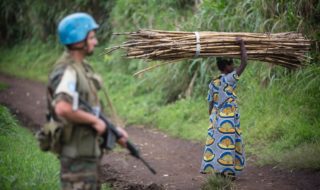Institutional collapse, not guns and bombs, is most-cited cause of wildlife declines from war
Breakdowns in institutions, societies and economies during conflicts often prove lethal, according to a new study
December 1, 2016
In conflict zones, the most common killers of wildlife are not guns and bombs, but breakdowns in institutions, societies and economies, according to a study by researchers at UC Berkeley.

Armed conflict cripples institutional capacity for conservation and law enforcement. (Photo by Henry Wismayer)
Societal upheaval during armed conflict drives unsustainable patterns of natural resource use that may have long legacies, so the authors call on biologists to join forces with social scientists and development organizations to further understand the complex outcomes of wars for animal populations and habitats.
“Conservation biologists often assume that war is bad for animals, with little understanding of the context and processes involved,” said Kaitlyn Gaynor, a Ph.D. candidate in the Department of Environmental Science, Policy and Management at UC Berkeley. “Such simplification overlooks the complexities of both war and conservation. Understanding the pathways that link conflict to environmental outcomes is critical to developing effective mitigation strategies.”
The study was published Dec. 1 in the journal Frontiers in Ecology and the Environment. The work was funded by the National Science Foundation, the Philomathia Foundation and the Atkinson Center for a Sustainable Future.

Conflict can alter patterns of natural resource extraction, driving wildlife habitat loss and degradation. (Photo by UN Photo/Sylvain Liechti)
Diverse consequences of armed conflict
Armed conflicts, from major wars to militia uprisings, have occurred in more than two-thirds of the world’s biodiversity hotspots over the past six decades. These conflicts are a major challenge for wildlife that is not addressed by traditional conservation strategies. Armed conflicts are often prolonged, creating lasting environmental changes. Seventy percent of current active conflicts began before 2000. Armed conflict can affect wildlife in a number of ways, including via tactical military operations, the displacement of people and the interruption of food supply systems.
For the study, the researchers reviewed case studies on conflicts from around the world, and developed a novel framework for understanding 24 distinct pathways that link conflict to environmental outcomes. Ten pathways directly resulted in the death of animals or changes in habitat. The other 14 pathways affected wildlife indirectly, creating circumstances that enabled easier or more profitable wildlife killing, habitat destruction or conservation.
Some of the most common direct causes of wildlife declines were from mines, bombs and chemicals, the destruction of habitat to gain battlefield advantages and the use of wildlife as a food source for combatants or displaced people.
The most common pathway linking armed conflict to wildlife declines was weakened institutional enforcement, cited in approximately half of the case studies. In the Okapi Reserve in the Democratic Republic of the Congo, park guards were forced to abandon their posts following attacks and were unable to prevent poaching. Other indirect pathways included a decline in conservation and research activities and the opening of new trade routes for wildlife products.
The researchers did find some cases of a positive effect of conflict on wildlife, particularly through the refuge effect that occurs when people flee war zones. A classic example is the unpopulated demilitarized zone between North and South Korea, which has hosted flourishing wildlife populations since 1953. Other positive outcomes include the creation of new habitat as byproduct of war tactics, and the confiscation of arms from hunters.
Overall, the 18 negative pathways were cited much more often than the six positive pathways, with the exception of the refuge effect. Ninety-four percent of case studies cited at least one pathway leading to negative outcomes for wildlife, whereas only 33 percent cited a positive pathway. The authors urge conservation practitioners to adopt a broad perspective on the consequences of armed conflict, as positive outcomes in one place and time often coincide with negative outcomes elsewhere.

The movement of people away from conflict areas can inadvertently create human-free wildlife refuges. However, these displaced people often rely heavily on natural resources around resettlement camps, to the detriment of wildlife habitat. (Photo by International Organization for Migration)
Effective conservation in wartime
Biological research is typically deprioritized in conflict areas, given threats to personal safety and lack of financial and institutional support. However, the authors argue that the identification of pathways and their interactions is a critical first step in mitigating environmental harm.
The authors suggest that conservation organizations target pathways that are most feasible given their own expertise, while supporting other organizations in mitigating related pathways. Many of the pathways associated with militarization can only be realistically addressed through postwar disarmament and environmental remediation. However, opportunities exist to reduce the negative impacts of war on wildlife by strengthening institutions that manage the environment before and during conflict.
“Wildlife conservation is understandably a low priority for those in the midst of a conflict,” said Lauren Withey, also a Ph.D. candidate in environmental science, policy and management and a co-author of the paper. “However, given the importance of wildlife to rural livelihoods, food security and national economies, conservation biologists and development practitioners working to mitigate the effects of conflict are making a valuable investment not only in biodiversity, but also in the region’s longer-term stability and the well-being of people.”